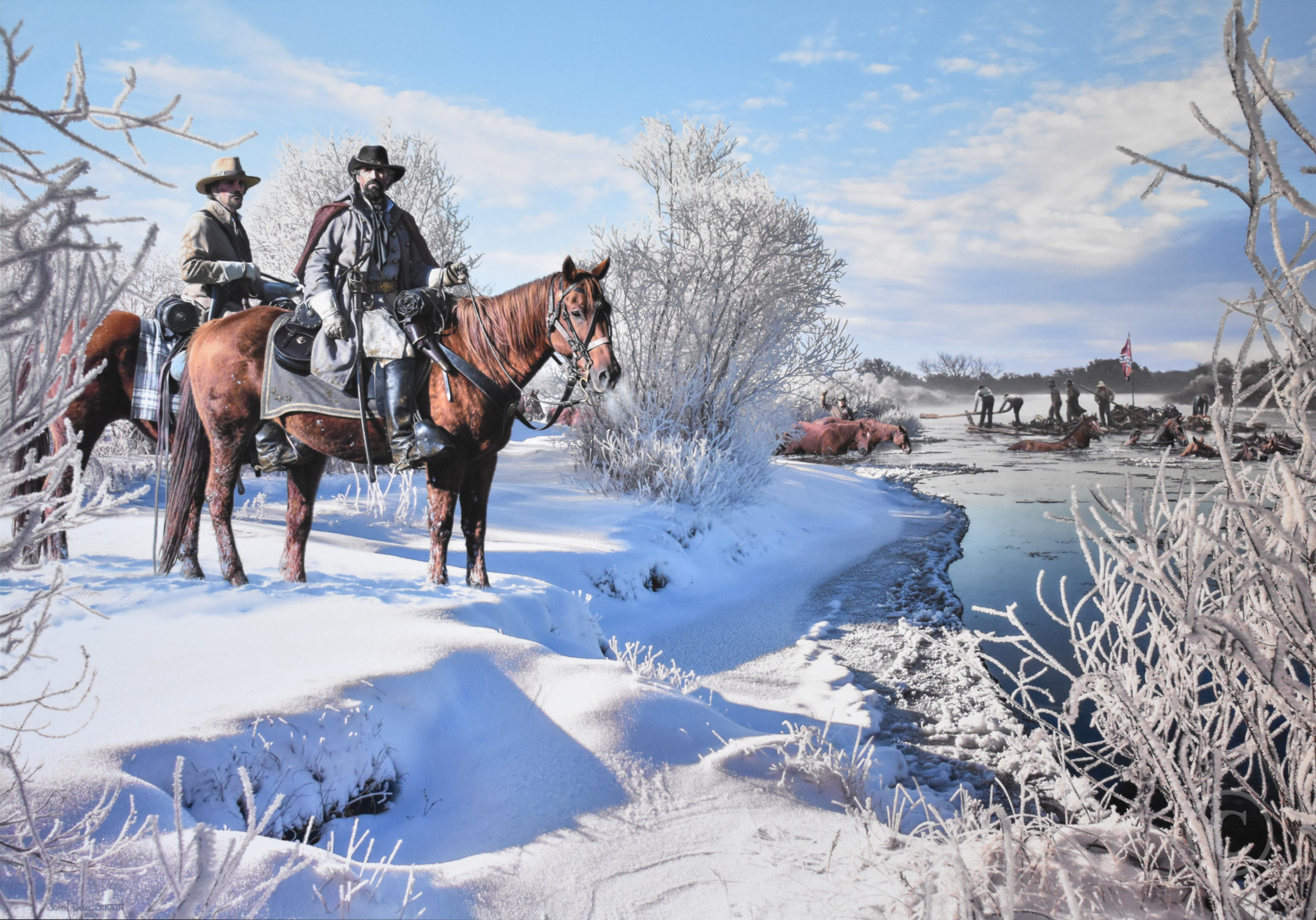CROSSING THE TENNESSEEGeneral N.B. Forrest & Major Jeffrey ForrestNear Clifton, Tennessee - January 1, 1863 
In October of 1862 General Nathan Bedford Forest was headquartered in Murfreesboro, assigned with the task of organizing and recruiting a new cavalry brigade. The brigade he had previously organized and equipped out of his own resources had been reassigned to another officer. His successful exploits with his old cavalry brigade had made him well known throughout the south, as well as in the north. General Forrest’s popularity was such that young men from the middle counties of Tennessee flocked to join his command, and within six weeks southern saddles were filled with a formidable force of eager Tennessee volunteers. Three regiments of Tennessee troops, the 4th Alabama Cavalry, two companies of Kentuckians, and one battery of artillery combined to form Forrest’s new brigade. Forrest petitioned General Bragg to equip his new brigade with modern weapons, as nearly half of the brigade carried no other arms other than personal shotguns, squirrel rifles, and 400 old flintlock muskets. Bragg responded that he had no arms to give, and to prepare for an expedition where better weapons would be captured from the enemy. Soon General Forrest was ordered to march to Columbia, cross the Tennessee River, and raid into the heart of Grant’s US Army of 27,000 troops in west Tennessee and northern Mississippi. Forrest’s plan was to break Grant’s communications, wreck his supply lines, destroy railroads, create fear and confusion among Union officers and troops, and raise hell generally. Crossing the Tennessee River was the first big challenge as the river level was high and Grant had five gunboats patrolling the waters with the specific task of preventing any southern incursion. On the 10th of December the expedition began. Forrest arrived at the river town of Clifton on the 15th and hid his brigade well back from the banks, sending sentries up and down the river to warn of any approaching Union gunboats. The work of crossing the river began at once, mostly at night. Ferryboats would run back and forth, eventually carrying 2100 men, horses, and seven artillery pieces across the three-fourths mile wide river. By the 17th, Forrest and his brigade had successfully crossed without the knowledge of the enemy. Once across, General Forrest’s strategy was to bluff the Federals into believing that a huge Confederate force was now approaching them. A number of kettle drums were pounded by men in different parts of his column, making it sound like a large army of infantry was moving. Soon Grant began receiving panicked reports of a southern force of ten to twenty thousand men advancing after crossing the river. Forrest’s men had their first engagement near Lexington and drove the Federals from their positions capturing 158 prisoners, six officers, and two cannons. Forrest continued his expedition going from town to town defeating any federal opposition they ran across, capturing supplies, new arms, equipment, and burning what was left. At Rutherford station two federal companies were captured and bridges, trestles, and rails were destroyed form Trenton to Kenton station. By Christmas, Forrest’s brigade had made a “clean sweep” destroying the Mobile and Ohio Railroad from Jackson and as far north as Moscow, Kentucky without a yard of trestlework standing. But now General Forrest’s scouts reported that a huge federal force of General Grant’s infantry were in pursuit. It was time for Forrest to complete the circle and make a dash back to the Tennessee River and home. Heavy snows impeded easy movement on the muddy roads. Forrest and his men were nearly surrounded at the battle of Parker’s Crossroads by an unexpectedly large force of federal infantry, but were able to escape. After marching all night General Forrest sent his younger brother Major Jeffrey Forrest at first light ahead to the river to prepare for the crossing. Jeffrey dispatched scouts up and down the river to watch for Union gun boats. Two flat boats had been successfully hidden from the gunboats and made ready. There was no time to bail out and re-float the ferries which had been sunk on purpose, after the previous crossing. Troops rapidly constructed rafts of fence rails and logs that would hold five to ten men. As company after company arrived at the river, horses were unsaddled and equipment, saddles, blankets, and guns were piled onto the rickety boats. Horses were made to swim across the river with some stout young men guiding them from their backs. Small fires and dry clothes would quickly warm them on the far banks. Over two thousand horses made the cold swim in the swift-flowing water. This remarkable feat took ten hours for two thousand men, horses, six pieces of artillery, a train of wagons and captured stores to cross the river. The incredible expedition cemented General Forrest’s reputation as one of the Confederacy’s great leaders. Archival Paper Giclées
Canvas Giclées
|


